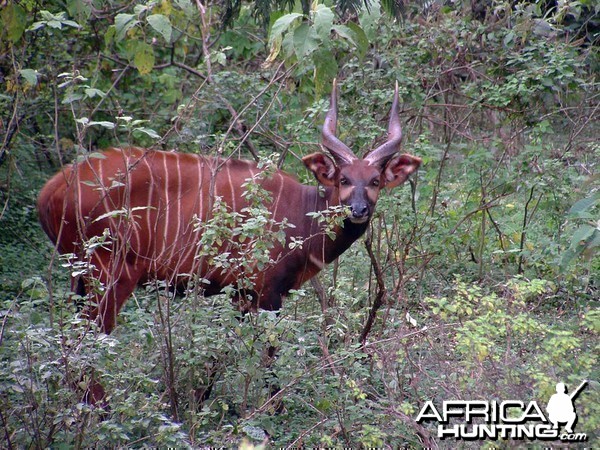- Joined
- Oct 1, 2007
- Messages
- 13,316
- Reaction score
- 9,591
- Website
- www.africahunting.com
- Media
- 5,597
- Articles
- 321
Eastern or Mountain Bongo (Tragelaphus euryceros isaaci) of Kenya

The Mountain Bongo Antelope is the flagship species of Kenya’s high mountain forests.
The Eastern or Mountain Bongo (Tragelaphus euryceros isaaci) is only found in the wild in one remote region of central Kenya, the Aberdare Mountain Range.
Once numerous within its restricted habitats it is now classified by the IUCN Antelope Specialist Group as Critically Endangered with more specimens in captivity than in the wild. All Bongos in captivity are from the isolated Aberdare Mountains of central Kenya. In the last few decades there has been a rapid decline in the numbers of wild Mountain Bongo due to poaching and human pressure on their habitat, with local extinctions reported in Cherangani and Chepalungu hills, Kenya.
The Bongo Surveillance Programme, working alongside the Kenya Wildlife Service, have recorded photos of Bongos at remote salt licks in the Aberdare Forests using camera traps, and, by analyzing DNA extracted from dung, have confirmed the presence of Bongo in Mount Kenya, Eburru and Mau forests. The programme estimate as few as 140 animals left in the wild - spread across four isolated populations. Whilst captive breeding programmes can be viewed as having been successful in ensuring survival of this species in Europe and North America, the situation in the wild has been less promising. Evidence exists of Bongo surviving in Kenya. However, these populations are believed to be small, fragmented and vulnerable to extinction.
Animal populations with impoverished genetic diversity are inherently less able to adapt to changes in their environment (such as climate change, disease outbreaks, habitat change, etc.). The isolation of the four remaining small bongo populations, which themselves would appear to be in decline, means that a substantial amount of genetic material is lost each generation. Whilst the population remains small, the impact of transfers will be greater, it is for that reason that the establishment of a "metapopulation management plan" occurs concurrently with conservation initiatives to enhance in-situ population growth and why this initiative is both urgent and fundamental to the future survival of Mountain Bongo in the wild.

The Eastern Mountain Bongo is larger and heavier than the Western Bongo
The Eastern Mountain Bongo’s survival in the wild is dependent on more effective protection of the surviving remnant populations in Kenya. If this does not occur, it will eventually become extinct in the wild. The existence of a healthy captive population of this subspecies offers the potential for its reintroduction.
The Mountain Bongo Antelope is the flagship species of Kenya’s high mountain forests.
The Eastern or Mountain Bongo (Tragelaphus euryceros isaaci) is only found in the wild in one remote region of central Kenya, the Aberdare Mountain Range.
Once numerous within its restricted habitats it is now classified by the IUCN Antelope Specialist Group as Critically Endangered with more specimens in captivity than in the wild. All Bongos in captivity are from the isolated Aberdare Mountains of central Kenya. In the last few decades there has been a rapid decline in the numbers of wild Mountain Bongo due to poaching and human pressure on their habitat, with local extinctions reported in Cherangani and Chepalungu hills, Kenya.
The Bongo Surveillance Programme, working alongside the Kenya Wildlife Service, have recorded photos of Bongos at remote salt licks in the Aberdare Forests using camera traps, and, by analyzing DNA extracted from dung, have confirmed the presence of Bongo in Mount Kenya, Eburru and Mau forests. The programme estimate as few as 140 animals left in the wild - spread across four isolated populations. Whilst captive breeding programmes can be viewed as having been successful in ensuring survival of this species in Europe and North America, the situation in the wild has been less promising. Evidence exists of Bongo surviving in Kenya. However, these populations are believed to be small, fragmented and vulnerable to extinction.
Animal populations with impoverished genetic diversity are inherently less able to adapt to changes in their environment (such as climate change, disease outbreaks, habitat change, etc.). The isolation of the four remaining small bongo populations, which themselves would appear to be in decline, means that a substantial amount of genetic material is lost each generation. Whilst the population remains small, the impact of transfers will be greater, it is for that reason that the establishment of a "metapopulation management plan" occurs concurrently with conservation initiatives to enhance in-situ population growth and why this initiative is both urgent and fundamental to the future survival of Mountain Bongo in the wild.
The Eastern Mountain Bongo is larger and heavier than the Western Bongo
The Eastern Mountain Bongo’s survival in the wild is dependent on more effective protection of the surviving remnant populations in Kenya. If this does not occur, it will eventually become extinct in the wild. The existence of a healthy captive population of this subspecies offers the potential for its reintroduction.
Last edited by a moderator: